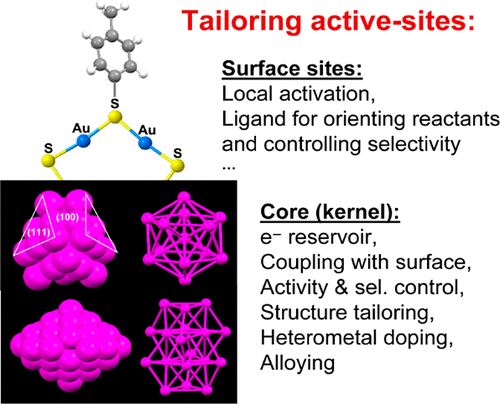当前位置:
X-MOL 学术
›
Chem. Rev.
›
论文详情
Our official English website, www.x-mol.net, welcomes your
feedback! (Note: you will need to create a separate account there.)
Toward Active-Site Tailoring in Heterogeneous Catalysis by Atomically Precise Metal Nanoclusters with Crystallographic Structures
Chemical Reviews ( IF 51.4 ) Pub Date : 2020-09-17 , DOI: 10.1021/acs.chemrev.0c00495 Rongchao Jin 1 , Gao Li 2 , Sachil Sharma 2 , Yingwei Li 1 , Xiangsha Du 1
Chemical Reviews ( IF 51.4 ) Pub Date : 2020-09-17 , DOI: 10.1021/acs.chemrev.0c00495 Rongchao Jin 1 , Gao Li 2 , Sachil Sharma 2 , Yingwei Li 1 , Xiangsha Du 1
Affiliation

|
Heterogeneous catalysis involves solid-state catalysts, among which metal nanoparticles occupy an important position. Unfortunately, no two nanoparticles from conventional synthesis are the same at the atomic level, though such regular nanoparticles can be highly uniform at the nanometer level (e.g., size distribution ∼5%). In the long pursuit of well-defined nanocatalysts, a recent success is the synthesis of atomically precise metal nanoclusters protected by ligands in the size range from tens to hundreds of metal atoms (equivalently 1–3 nm in core diameter). More importantly, such nanoclusters have been crystallographically characterized, just like the protein structures in enzyme catalysis. Such atomically precise metal nanoclusters merge the features of well-defined homogeneous catalysts (e.g., ligand-protected metal centers) and enzymes (e.g., protein-encapsulated metal clusters of a few atoms bridged by ligands). The well-defined nanoclusters with their total structures available constitute a new class of model catalysts and hold great promise in fundamental catalysis research, including the atomically precise size dependent activity, control of catalytic selectivity by metal structure and surface ligands, structure–property relationships at the atomic-level, insights into molecular activation and catalytic mechanisms, and the identification of active sites on nanocatalysts. This Review summarizes the progress in the utilization of atomically precise metal nanoclusters for catalysis. These nanocluster-based model catalysts have enabled heterogeneous catalysis research at the single-atom and single-electron levels. Future efforts are expected to achieve more exciting progress in fundamental understanding of the catalytic mechanisms, the tailoring of active sites at the atomic level, and the design of new catalysts with high selectivity and activity under mild conditions.
中文翻译:

在具有晶体学结构的原子精确金属纳米簇的催化作用下,实现主动站点定制
非均相催化涉及固态催化剂,其中金属纳米颗粒占据重要位置。不幸的是,尽管常规规则的纳米颗粒在纳米水平上可能是高度均匀的(例如,粒径分布约为5%),但在原子水平上没有两个纳米颗粒是相同的。在对定义明确的纳米催化剂的长期追求中,最近的成功是合成了原子精确的金属纳米簇,这些纳米簇受配体保护,其大小范围从数十个到数百个金属原子(相当于核直径的1-3 nm)。更重要的是,这种纳米簇已经在晶体学上得到了表征,就像酶催化中的蛋白质结构一样。这种原子精确的金属纳米簇融合了定义明确的均相催化剂(例如配体保护的金属中心)和酶(例如 ,是由配体桥接的几个原子的蛋白质包裹的金属簇)。定义明确的纳米团簇及其总结构构成了新型的模型催化剂,在基础催化研究中具有广阔的前景,包括原子精确的尺寸依赖性活性,金属结构和表面配体对催化选择性的控制,结构与性质之间的关系。原子级,对分子活化和催化机理的见识以及纳米催化剂上活性位点的鉴定。这篇综述总结了利用原子精确的金属纳米团簇进行催化的进展。这些基于纳米团簇的模型催化剂使得能够在单原子和单电子水平上进行多相催化研究。
更新日期:2020-09-17
中文翻译:

在具有晶体学结构的原子精确金属纳米簇的催化作用下,实现主动站点定制
非均相催化涉及固态催化剂,其中金属纳米颗粒占据重要位置。不幸的是,尽管常规规则的纳米颗粒在纳米水平上可能是高度均匀的(例如,粒径分布约为5%),但在原子水平上没有两个纳米颗粒是相同的。在对定义明确的纳米催化剂的长期追求中,最近的成功是合成了原子精确的金属纳米簇,这些纳米簇受配体保护,其大小范围从数十个到数百个金属原子(相当于核直径的1-3 nm)。更重要的是,这种纳米簇已经在晶体学上得到了表征,就像酶催化中的蛋白质结构一样。这种原子精确的金属纳米簇融合了定义明确的均相催化剂(例如配体保护的金属中心)和酶(例如 ,是由配体桥接的几个原子的蛋白质包裹的金属簇)。定义明确的纳米团簇及其总结构构成了新型的模型催化剂,在基础催化研究中具有广阔的前景,包括原子精确的尺寸依赖性活性,金属结构和表面配体对催化选择性的控制,结构与性质之间的关系。原子级,对分子活化和催化机理的见识以及纳米催化剂上活性位点的鉴定。这篇综述总结了利用原子精确的金属纳米团簇进行催化的进展。这些基于纳米团簇的模型催化剂使得能够在单原子和单电子水平上进行多相催化研究。











































 京公网安备 11010802027423号
京公网安备 11010802027423号